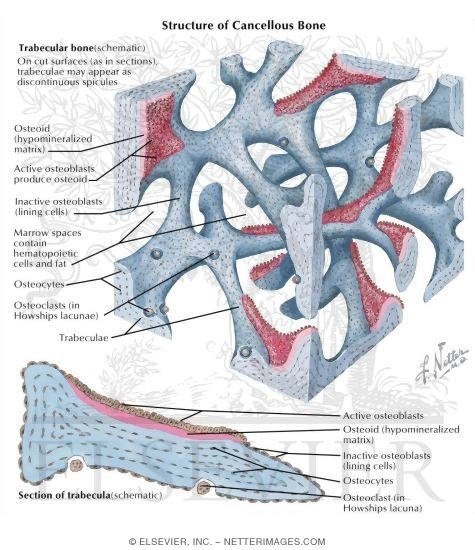Trabecular bone is the spongy/porous bone that provides strength and shock absorption (with light weight) in bone near joints, and especially in the bones of the feet. Trabecular bone remodels itself in response to the strains it experiences. With this project I'm hoping to find that endurance running causes unique and predictable trabecular bone adaptation in foot bones. If so, this would be new to science, and more importantly would suggest a way to infer locomotive behavior from hominin fossils. In other words, we could look at fossils and determine whether a hominin (human ancestor) actually ran. I've also split up my running group into forefoot and rearfoot runners, hoping to perhaps find differences between them. (Spoiler from the poster linked above-- forefoot runners have thicker trabeculae in their calcaneus, significantly so when body weight is factored in.)
Anistropy is a measure of how parallel the trabeculae (individual struts of bone--below) are to one another. In other words-- are they aligned in the same direction, a response to consistent strain patters? Or are they isotropic, with a more crosshatch pattern, making the bone strong in various directions and indicating a variable or low-strain loading history?

The hot new thing in trabecular research is degree of anisotropy (DA). We know that anistropy increases as an adaptation to repeated strain, as does trabecular thickness. I was surprised not to find thicker trabeculae in the metatarsals of runners, but I did find it in the calcaneus of forefoot runners, so I expected to find higher anistropy for both bones in runners. Here's what I did:
Whereas the program I used initially is capable of distinguishing bone from soft tissue, and trabecular bone from cortical bone, this new program can't, so I couldn't just give the program the whole stack of images. Shucks...user input required. So I defined a "region of interest" (ROI) comprising specific, small areas of the scans we took of the calcaneus and 1st metatarsal bones. The whole stacks are shown below. The small ROI's were then analyzed for degree of anisotropy (DA) using the mean intercept length method. Basically, the program looks at the trabeculae and measures how far you can travel down each one without hitting a connection to another one. Farther distance means they're oriented more parallel to each other... anisotropic.
 |
| posterior calcaneus, 9 mm thick stack, near the Achilles tendon insertion. For anistropy, I looked at a small ROI in the center of this stack. |
 |
| 1st metatarsal, 9 mm thick stack, near the head. For anistropy, I looked at a small ROI in the dorsal (upper) region, where other studies indicate anistropy is highest. |
Findings (will try to publish this so I'm not giving away the farm here...!)
My small sample size of about 14 didn't yield statistically significant results*. Not surprising. The exciting thing is that for the metatarsal, runners do indeed have more anisotropic bone structure than nonrunners-- the means are intriguing and as expected. One weird outlier is skewing things a bit (typical of small sample sizes), and without him, p-values would be under that magical and arbitrary .05 threshold. No real differences are observed between forefoot and rearfoot runners which makes sense because the 1st met does work during the second half of the stance phase, not so much at footstrike (though I should recheck the literature on this). Anistropy does not differ between any groups for the calcaneus, surprising given the trabecular thickness results. This could be resultant from several non-parallel networks of trabeculae which originate in this area of the calcaneus-- even high forces here wouldn't, then, increase anistropy.
*Dec 2015 edit: further analysis revealed a statistically significant result. p<.05. Translated from stats-speak into normal-human speak: There is less than a 5% chance that my results would be seen if there were no real effect of running and footstrike on metatarsal anisotropy. A significant p value is the difference between a happy and an unhappy scientist.
That's it for this installment of How Science Seems to Work with Newbie Drew. Stay tuned for the next part: writing a paper and trying to get it accepted for publication!
Interesting stuff! I wonder what kind of bone adaptations you'd see in jumping sports like basketball and indoor volleyball. I'd imagine the impact forces would be even higher for that group than runners. Good luck with the research and writing!
ReplyDelete